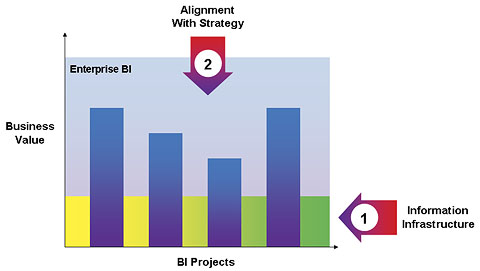A lot has been written about what typically goes wrong in individual BI projects (see my blog postings on the five fatal flaws, or check out articles such as Madan Sheina‘s recent “What went wrong with business intelligence?“)
But even when individual BI projects are successful, many organizations stumble on the journey to true enterprise BI deployments. What goes wrong?
First, organizations must realize that implementing enterprise BI is not simply about implementing a bigger BI project. Just as Tiger Woods decided that he needed to relearn his swing in order to take his game to the next level, organizations have to reconsider some of the basics of their BI deployments in order to move to enterprise BI. And just as in golf, some of the skills and approaches that are typically associated with initial success may actually hinder enterprise BI success.
Individual BI projects typically focus on expert users who work with high-value information. This is a great place to start, but it’s easy to over-deliver to a small number of vocal, technical users, and miss the greater value of a broad deployment to less-technical users.
With only experts using the system, the temptation is to:
- Fix problems such as data quality in a patchwork, ad-hoc way
- Tolerate poor ease-of-use and a confusing variety of different systems
- Provide information to non-expert users rather than rolling out self-service access.
And because this approach provides a rewarding role for BI experts, it may even lead them to have a vested interest in resisting a more comprehensive approach to enterprise BI.

Diagram: Moving from a series of successful BI projects to enterprise-wide BI deployments involves changing some of the habits that made the initial projects successful. Two key initiatives are required, involving new approaches and audiences
After review of organizations that have implemented enterprise BI, there are broadly two sets of initiatives that are highly correlated with success, both involving reaching out to different users than individual BI projects.
Initiative 1: Implementing an Information Infrastructure
After several key successful projects are in place, successful companies start “filling in” a broad foundation of information use throughout the organization, with the following elements:
- A systems approach to data quality (rather than ad-hoc fixing of numbers)
- Simpler data access for a broader range of users (along with greater investment in training and best practice)
- An emphasis on collaboration and discussion around data
- Making information actionable by embedding BI directly into operational systems, at the point of decision
This information infrastructure approach puts the right framework in place for a culture of information use and fact-based decision-making. It fosters a virtuous spiral of increasing numbers of employees accessing, analyzing, and sharing data and improving operational performance.
Supporting this information infrastructure typically requires organizational and technology changes. Some form of BI competency center is essential, tasked with the optimal use of information across the organization as whole. And one key task of the BI competency center is to standardize the BI products used in the organization, favoring systems that have the openness, breadth, and integrated approach to support the variety of environments and profiles that exist throughout the organization.
Initiative 2: Aligning Information Use with Corporate Strategy
Having an good information infrastructure isn’t enough. If enterprise BI is only “part of the plumbing”, it won’t get the resources required to thrive over the longer term.
The second initiative that correlates with enterprise BI success is making sure that there’s a strong link between the information systems and the strategic directions of the company.
In most organizations, there are two types of dashboards: bottom-up, automated dashboards that track the performance of a particular process or business unit, and top-down manual dashboards that track strategic initiatives. And there’s typically a huge gap between them.
Organizations increasingly realize that they have to take a systems approach to linking strategy to execution. Bridging the gap between IT and Finance is crucial to the success of this initiative, Financial and strategic planning systems are essential pieces of the enterprise BI puzzle. IT has to work with the finance function to tie the financial systems more tightly to operational systems through integrated financial and non-financial key performance indicators, enhanced business reporting, and scorecards.
Conclusion
(1) You might have to take a step backwards in order to take two steps forward.
(2) It’s time to start bridging the gap between IT and Finance.
The big question is this: why don’t more people take that step “back” to turn their BI success into a solid foundation — incentives? politics? is there simply not the time to concentrate on strategy when the existing projects need to be dealt with?

Comments
One response to “Two Key Steps From Project to Enterprise BI”
It is nice your blog very clear points of view. And very struture in you information.
I will link you in my blog